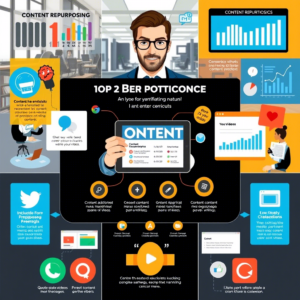In today’s digital world, having a strong brand voice is no longer optional—it’s essential. Whether you’re running a small business or managing an international corporation, your brand’s tone and personality shape how customers perceive you.
Imagine this: You post the same message on Instagram, Twitter, and LinkedIn but notice vastly different engagement levels. Why does this happen? Because each platform has its own audience and culture, and adapting your brand voice accordingly can make all the difference.
Building a cohesive brand voice across multiple social platforms isn’t just about consistency; it’s about authenticity. It means understanding who your audience is on each platform and tailoring your communication while staying true to your core values.
In this article, we’ll explore five key strategies to help you create a powerful brand voice that resonates with audiences everywhere. By the end of this piece, you’ll have actionable insights to implement immediately in your marketing efforts.
1. Understand Your Audience on Each Platform
The first step in building a strong brand voice is knowing where your audience spends their time online—and why. Not every social media user behaves the same way. For instance:
- Instagram users are visual and often seek inspiration through images and short videos.
- Twitter attracts people looking for quick updates, news, and witty banter.
- LinkedIn caters to professionals seeking career advice, industry trends, and networking opportunities.
To craft messages that resonate, dive deep into demographics. Tools like Facebook Insights, Twitter Analytics, and LinkedIn Campaign Manager provide valuable data about age groups, interests, and peak activity times. Use these insights to tailor your tone. For example:
- On Instagram, focus on storytelling with eye-catching visuals and captions that evoke emotion.
- On Twitter, keep things concise, humorous, or thought-provoking depending on your niche.
- On LinkedIn, adopt a more formal yet approachable tone, emphasizing expertise and credibility.
By aligning your content with what your audience expects from each platform, you ensure your brand voice feels natural and relatable.
2. Define Your Core Brand Values
Your brand voice should reflect your company’s mission, vision, and values. Without clear guidelines, your messaging risks becoming inconsistent or inauthentic. Start by asking yourself:
- What makes our brand unique?
- How do we want customers to feel when interacting with us?
- Which words best describe our brand identity (e.g., friendly, professional, innovative)?
Once defined, document these principles in a “Brand Voice Guide.” This document will serve as a reference for everyone involved in creating content. Here’s an example:
- Tone : Conversational but authoritative.
- Language Style : Avoid overly technical jargon unless necessary.
- Key Themes : Sustainability, community involvement, customer satisfaction.
Having a well-defined brand voice ensures that whether someone interacts with you on TikTok or Pinterest, they receive the same level of quality and personality.
3. Leverage Visual Consistency
While text plays a crucial role in shaping your brand voice, visuals matter just as much. Colors, fonts, imagery styles, and even emojis contribute to how your audience perceives you. Consider brands like Coca-Cola and Apple—they maintain consistent visual elements across all channels, reinforcing their identities.
Here’s how you can achieve similar success:
- Develop a signature color palette and typography style.
- Create templates for posts so designs remain uniform regardless of the creator.
- Choose filters or editing tools that align with your aesthetic.
For example, if your brand represents luxury, use high-resolution photos with soft lighting and muted tones. If you’re targeting younger audiences, vibrant colors and playful graphics might work better. Remember, consistency builds trust, making it easier for followers to recognize your brand instantly.
4. Adapt Content for Each Platform
Even with a unified brand voice, one-size-fits-all content rarely works. Different platforms require distinct formats and lengths. Here’s how to adapt effectively:
Short-form platforms (Twitter, TikTok) : Keep sentences brief and impactful. Use hashtags strategically to increase visibility.
Long-form platforms (LinkedIn, Medium) : Dive deeper into topics, providing analysis or case studies that demonstrate authority.
Visual-heavy platforms (Instagram, Pinterest) : Prioritize stunning visuals accompanied by engaging captions.
Additionally, consider repurposing content. A blog post could become a thread on Twitter, a carousel on Instagram, or a SlideShare presentation on LinkedIn. However, always tweak the delivery to suit the platform’s norms. For instance, breaking down complex ideas into bite-sized tweets keeps users engaged without overwhelming them.
5. Engage Authentically with Your Community
A strong brand voice isn’t built solely on outbound communication—it thrives on interaction. Responding to comments, participating in conversations, and collaborating with influencers humanizes your brand. People appreciate authenticity, and genuine interactions foster loyalty.
Here are some tips for fostering meaningful connections:
- Monitor mentions and hashtags related to your brand across platforms.
- Address negative feedback constructively, turning criticism into opportunities for improvement.
- Share user-generated content to show appreciation for your community.
Take Nike, for example. Their campaigns often highlight real athletes’ stories, creating emotional resonance with viewers. Similarly, responding promptly to customer queries shows that you value their input and care about maintaining a positive relationship.
Conclusion
Creating a strong brand voice across multiple social platforms requires strategic planning, adaptability, and consistency. By understanding your audience, defining your core values, leveraging visual consistency, adapting content for each platform, and engaging authentically, you can build a presence that stands out in a crowded digital landscape.
So, here’s your call to action: Take one of the strategies discussed today and apply it to your next campaign. Did you discover something new about your audience? Or perhaps you found a creative way to repurpose existing content? Let us know in the comments below—we’d love to hear your thoughts!
And remember, building a strong brand voice is not a sprint—it’s a marathon. Stay committed, stay curious, and watch your brand flourish.




